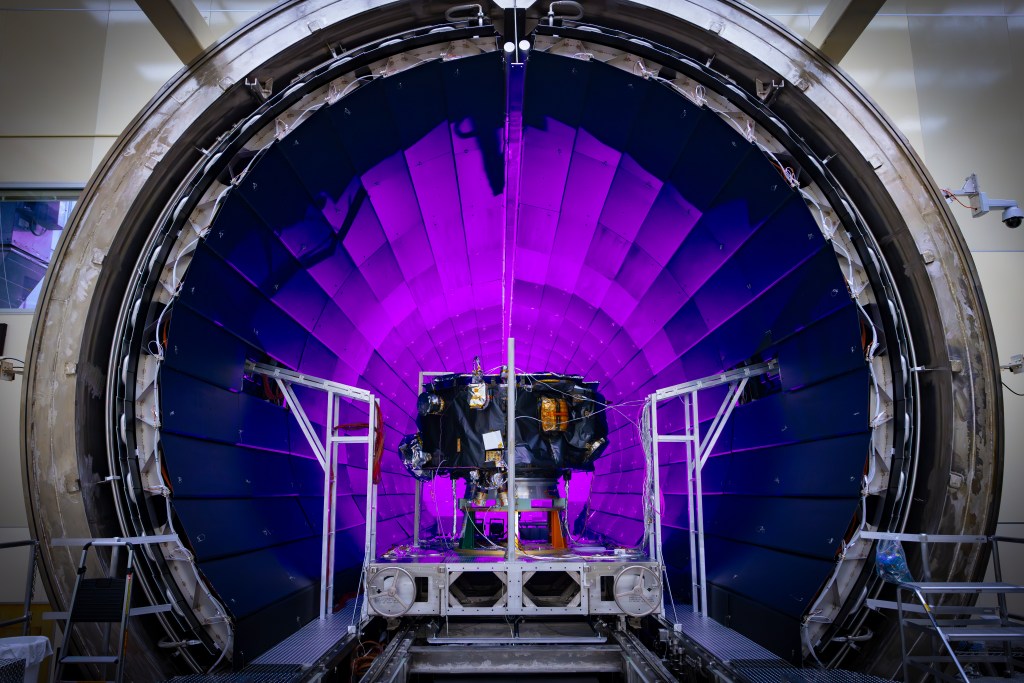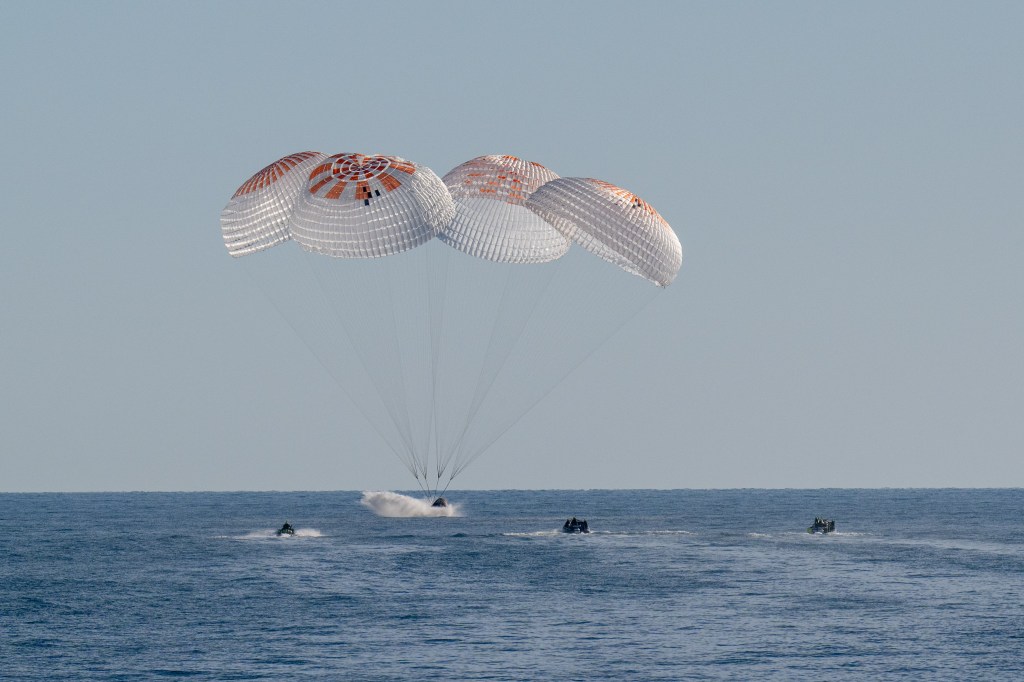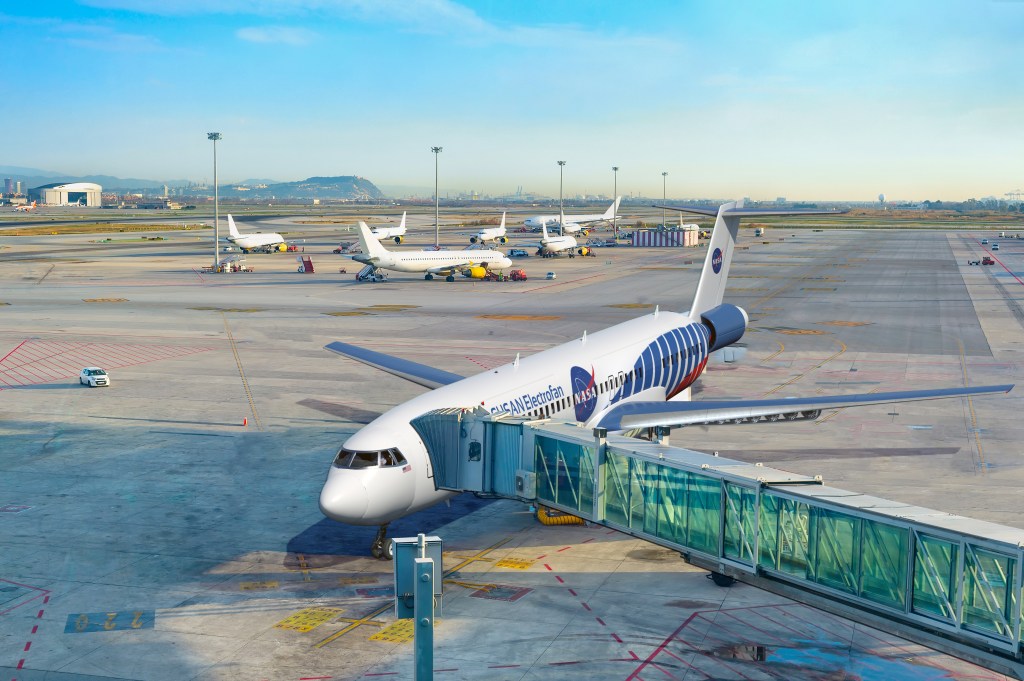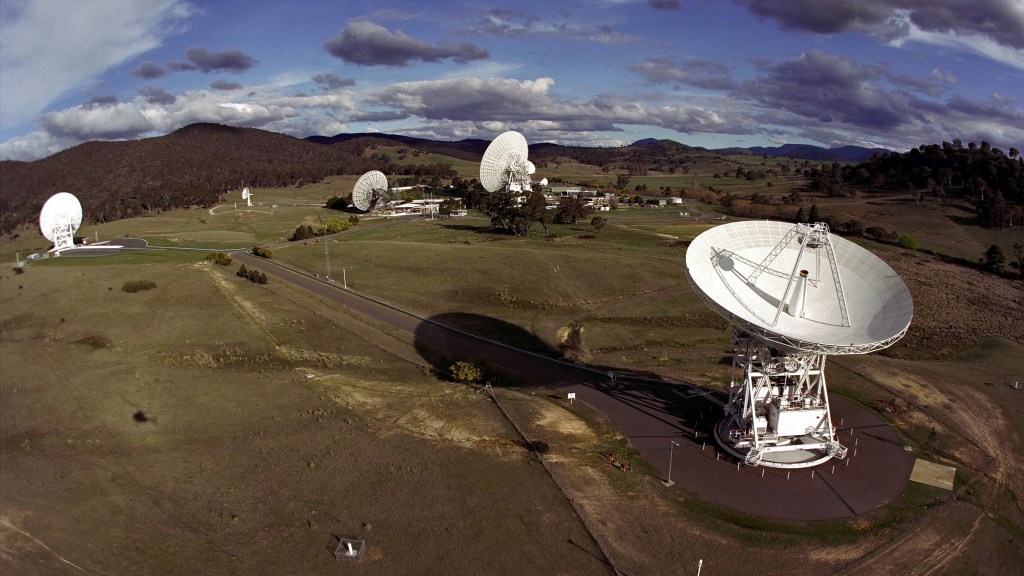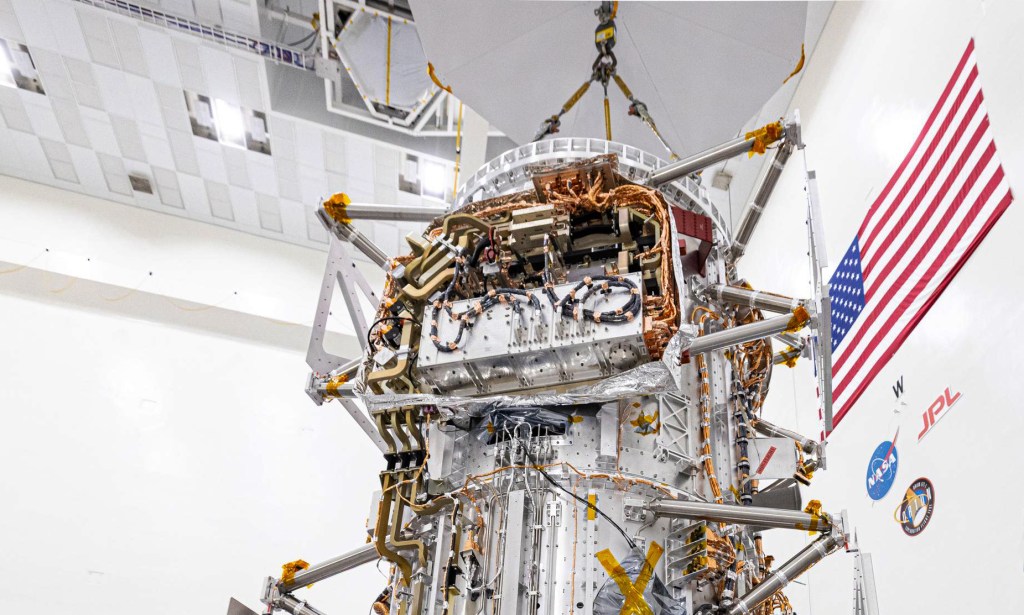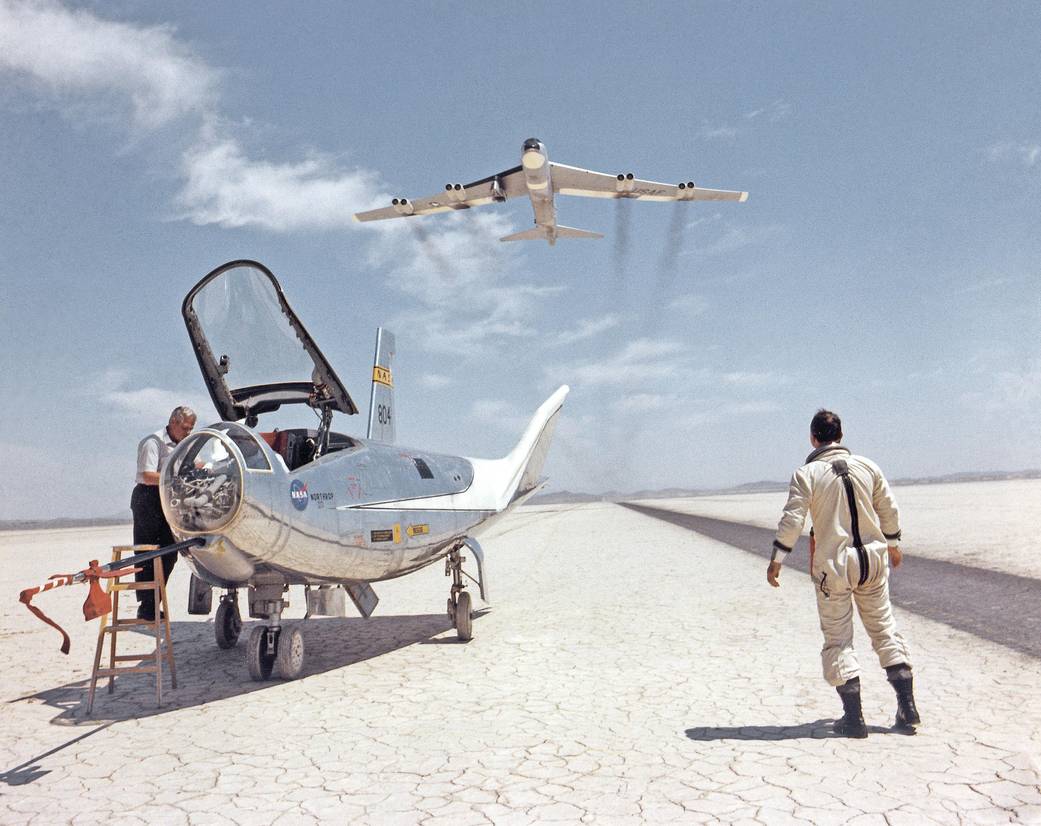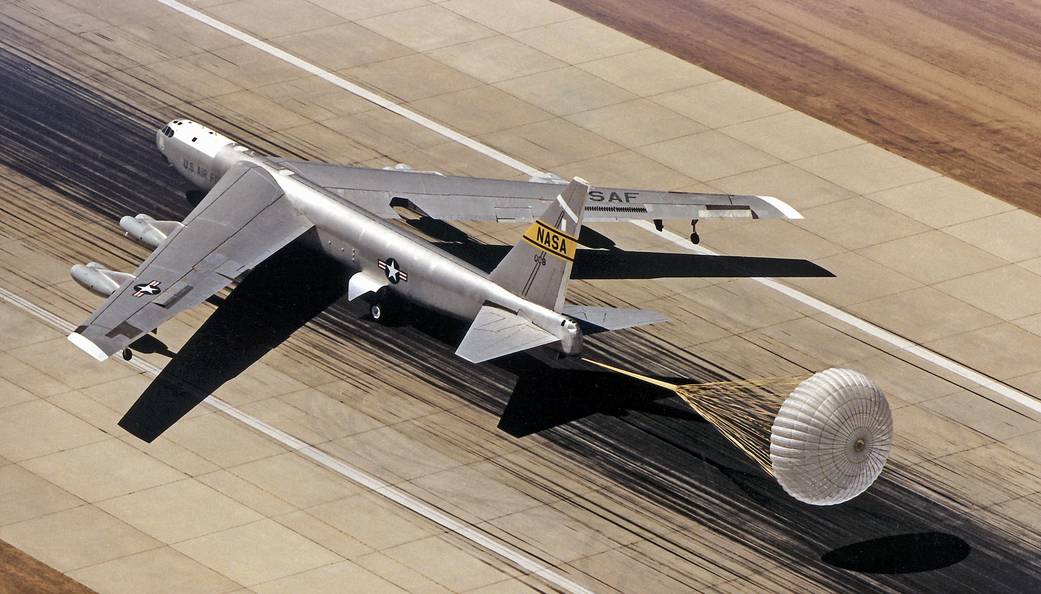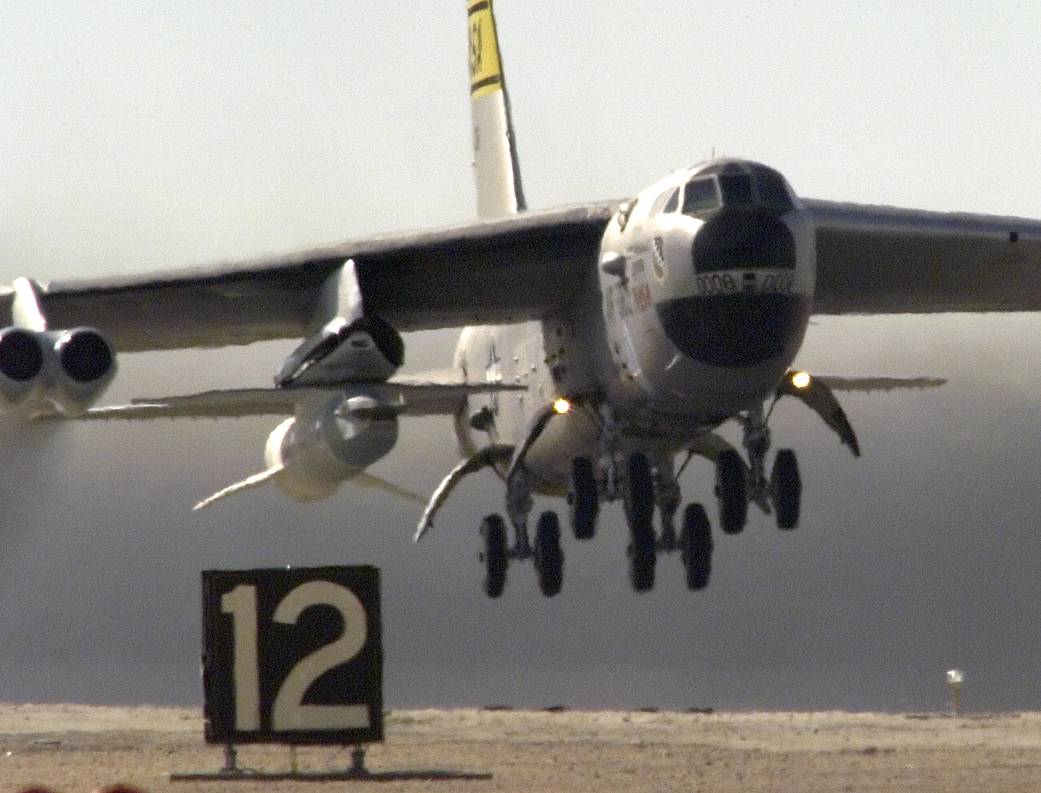B-52 Heavy-lift Airborne Launch Aircraft
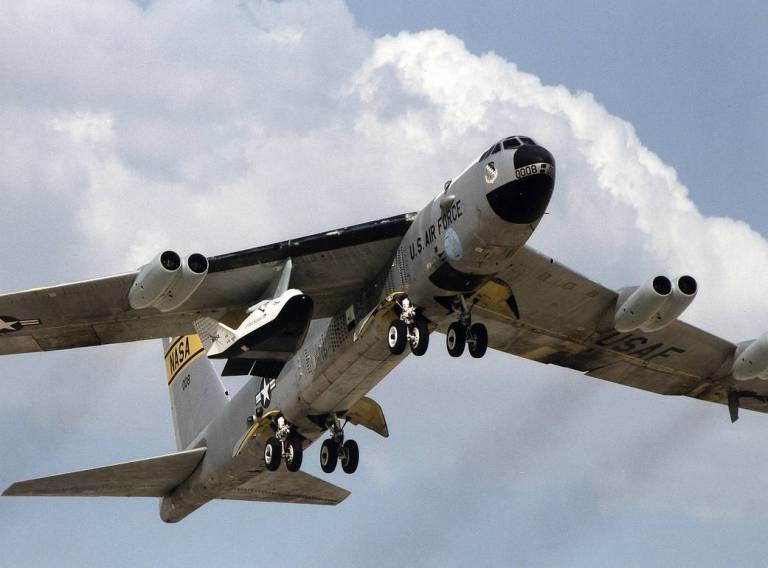
B-52B
NASA’s B-52B launch aircraft, operated by Dryden (now Armstrong) Flight Research Center, participated in some of the most significant projects in aerospace history. At retirement, the air launch and research aircraft held the distinction of being NASA’s oldest aircraft, as well as being the oldest B-52 on flying status. At the same time, it had the lowest number of flying hours (2443.8) of any B-52 in operation, having been used exclusively in the role it continued to perform so reliably for nearly 50 years.
The B-52B, registration number 52-0008 (NASA tail number 008), rolled out of Boeing’s Seattle plant as an RB-52B, and first flew on June 11, 1955. The aircraft was the 10th B-52 to come off the Boeing assembly line and was a U.S. Air Force test aircraft before it was assigned to support the X-15 research aircraft program at Dryden.
B-52B Missions
X-15 Program
NASA TN 008 was one of two B-52s used as air launch platforms for the three rocket-powered X-15s. Aircraft TN 008 was the launch aircraft on 140 of the X-15 flights and flew a total of 159 captive-carry and launch missions in that program.
Flown between June 1959 and October 1968, the X-15 set world speed and altitude records of Mach 6.7 and 354,200 feet in a program that investigated all aspects of manned hypersonic flight. Information gained from the X-15 program contributed to development of the Mercury, Gemini, Apollo, and Space Shuttle manned space flight programs.
The other B-52 used in the X-15 program, TN 003, was retired in 1969 and is on permanent display at the Pima County Air Museum in Tucson, Arizona.
The Lifting Bodies
Between 1966 and 1975, B-52 TN 008 launched 127 of the 144 flights of the lifting body aircraft.
Lifting bodies obtain aerodynamic lift from the shape of their bodies. The addition of fins and control surfaces allowed research pilots to stabilize and control the vehicles and maintain a predetermined flight path. Research flights with the vehicles proved that such low lift-to-drag aircraft could enter the atmosphere from space and be flown to a safe runway landing.
Space Shuttle Program Support
In 1977 and 1978, and again in the 1983 to 1985 time period, TN 008 was used as the launch aircraft in the test and development of the parachute recovery system used to recover the Space Shuttle’s solid rocket boosters.
From July to October of l990, it flew eight tests of a drag chute deployment system being installed on Space Shuttle orbiters.
The drag chutes permit the orbiters to land safely in a shorter distance and also help reduce tire and brake wear. The test unit, consisting of the test drag chute and its attachment and deployment systems, was installed in the tail of NASA TN 008, along with instrumentation to record loads and pressures on the deployed parachute and also on the structure of the aircraft.
Tests were carried out at landing speeds ranging from 160 to 230 mph on a lakebed runway and also on the main concrete runway at Edwards. They demonstrated the initiation, deployment, inflation, and overall operation of the orbiter drag chute system. Data from the tests were used to validate predicted loads.
First operational use of the drag chute system was on Shuttle Endeavour, newest of the space shuttle fleet, during its first landing May 16, 1992.
Miscellaneous Support
NASA TN 008 was the launch aircraft for several remotely piloted aircraft flown by Dryden in the 1970s and l980s to study spin-stall, high angle of attack, and maneuvering characteristics: the sub-scale F-15 spin research vehicle; the HiMAT (Highly Maneuverable Aircraft Technology) research aircraft; and the DAST (Drones for Aerodynamic and Structural Testing) project, which investigated aerodynamic loads alleviation during flutter.
It was used for a lengthy set of test flights began in 1979 for a U. S. Air Force project to certify an extension of the operational life of the parachute recovery system on the F-111 crew escape module. The tests concluded in 1992.
NASA TN 008 was used as the air launch platform for the first six commercially developed Pegasus rocket boosters, a three-stage rocket designed to put a payload into earth orbit after launching horizontally from beneath a carrier aircraft’s wing.
Developed by Orbital Sciences Corporation under sponsorship of the DARPA (Defense Advanced Research Projects Agency) as part of the agency’s Advanced Space Technology Program, Pegasus served as a comparatively small booster.
The first Pegasus launch from NASA TN 008 was on April 5, 1990, over the Pacific Ocean, about 60 miles southwest of Monterey, California.
NASA TN 008’s primary mission for several years was as the launch platform for the X-38 Crew Return Vehicle. The maiden free-flight of the X-38 prototype space station lifeboat occurred in March 1998. Mission support continued until the X-38 project was canceled in 2001.
Hyper-X
In its final role in aerospace history, NASA TN 008 served as the launch aircraft for NASA’s Hyper-X project. The project’s primary purpose was to explore mixed propulsion system for lower cost space access. The Hyper-X project flew three unmanned 12-foot-long, integrated supersonic ramjet, or scramjet-powered X-43A research vehicles.
The first X-43A vehicle was lost on June 2, 2001, following termination of the flight after the Pegasus-derived booster rocket deviated from the planned trajectory. This was because, when launched at a lower altitude than the booster typically were, the aerodynamic forces overcame the control fins ability to do their jobs and at least one broke off in flight, leaving the booster uncontrollable.
The second X-43A launch proved not just that hypersonic scramjet-powered flight was possible, but that it demonstrated thrust sufficient to overcome drag: it accelerated. On March 27, 2004, NASA TN 008 carried the X-43, and its Pegasus booster to the drop altitude of 40,000 feet and released the pair. The rocket accelerated and climbed the X-43A to its test altitude of about 95,000 feet over the Pacific Ocean, where the X-43A separated from the booster and flew freely at its test speed of Mach 6.8.
The third and final X-43A also flew on Nov. 16, 2004, demonstrating that it could sustain a selected speed despite the drag it incurred. It flew at about Mach 9.6.
It is interesting to note that NASA TN 008’s first and last mission launched hypersonic research vehicles, the first being launch of the No. 1 X-15 in 1960.
B-42B Retirement
Having participated in some of the most significant projects in aerospace history, NASA TN 008 was formally retired on Dec. 17, 2004, in a joint NASA and U.S. Air Force ceremony and returned to the Air Force. It is now on permanent public display near the north gate of Edwards Air Force Base in California.
B-52B Aircraft Modifications
A major structural modification to the B-52B was the cutout of a large notch in the aircraft’s right inboard wing flap to accommodate the vertical tail on the three X-15 aircraft. This notch also served the Pegasus and Hyper-X projects. More significantly, the spar was built up for the increased weight suspended under the right wing. Because of the notch cut out of one of the flaps, and the presence of an experiment close to them, TN 008’s flaps were permanently disabled.
The center designed and built a variety of pylons for different vehicles, always attached under the right wing between the inboard engine pod and fuselage. Each pylon was subjected to extensive drag, airflow, and loads testing before use. On a historical note, the pylon used to attach the X-43A and its booster to the B-52B is the same pylon used for the X-15 program: two hypersonic programs.
NASA TN 008 carried special instrumentation to record and transmit test and research data and video to the Dryden Mission Control Room or other receivers during research missions. A second Launch Panel Operator position was added to augment the existing one for the Hyper-X project.
B-52B Aircraft Specifications
The NASA B-52B was powered by eight Pratt & Whitney J-57-19 turbojet engines, each capable of producing 12,000 pounds of thrust with water injection at takeoff. The civilian version was the JT3 turbojet that powered Boeing 707s and Douglas DC-8s. The B-52 had a top speed of 390 knots (448 mph) and a maximum operating altitude of more than 50,000 feet. It is 156 feet long, and has a wingspan of 185 feet.
The heaviest load the B-52B carried since it became a NASA launch aircraft was 53,100-pound No. 2 X-15 with external fuel tanks used during that aircraft’s fastest flights. The second heaviest load, at 47,772 pounds, was the Space Shuttle solid rocket booster recovery system tests, while the third heaviest load carried was the Pegasus rocket, weighing in at 41,152 pounds. When it released the experiment, especially if it were heavy, as the X-15s were, the B-52 would roll dramatically the opposite way even though the crew knew it would happen. They also pumped fuel from one side to the other to balance the aircraft when carrying the heavier experiments.
B-52H
NASA obtained a B-52H heavy bomber from the U.S. Air Force in 2001, intending to use the aircraft as an air-launch and testbed aircraft to support NASA, Air Force, and industry flight research and advanced technology demonstration efforts at NASA Dryden (now Armstrong).
Dryden’s fabrication branch built a new, in-house-designed pylon for the B-52H to carry aerospace test vehicles aloft. The new pylon was designed with the flexibility to adapt to the variety of aerospace vehicle shapes and sizes, and could carry a load weighing up to 25,000 pounds.
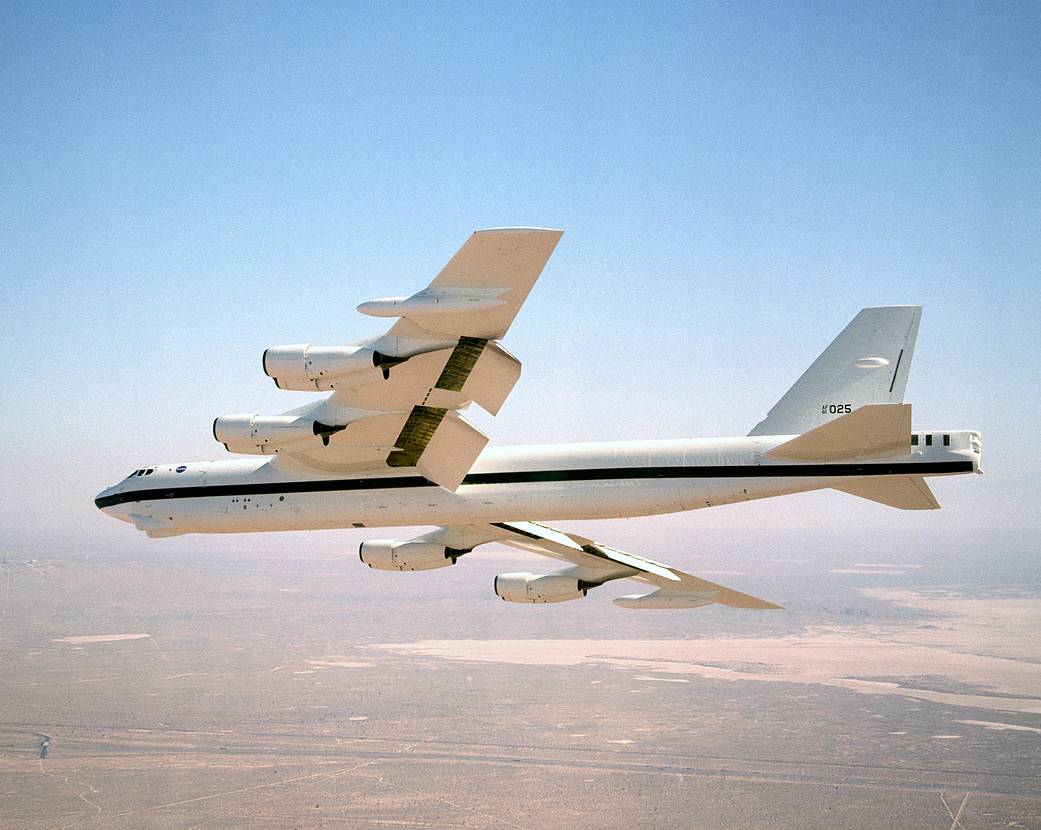
The B-52H, USAF serial number 61-0025, arrived at NASA Dryden on July 30, 2001, from the USAF’s 23rd Bomb Squadron, 5th Bombardment Wing, located at Minot Air Force Base, North Dakota. Initially placed on loan, the aircraft was later transferred from the USAF to NASA.
The B-52H was intended to replace Dryden’s famous B-52B TN 008, which was retired on Dec. 17, 2004. However, with no research projects requiring its capabilities on the horizon under NASA’s restructured aeronautics research programs, the decision was made to return the aircraft to the Air Force, which intended to use it as a training aid for B-52 ground technicians. Physical transfer of the aircraft was expected to occur in mid-2007.
B-52H Aircraft Specifications
Contractor: The Boeing Military Airplane Co.
Engines: Eight Pratt & Whitney TF33-P-3/103 turbofan engines.
Thrust: Each engine up to 17,000 pounds.
Length: 159 feet, 4 inches (48.5 meters).
Height: 40 feet, 8 inches (12.4 meters).
Wingspan: 185 feet (56.4 meters).
Maximum never-exceed speed: 650 miles per hour (Mach 0.86).
Ceiling: 50,000 feet (15,151.5 meters).
Weight: Approximately 185, 000 pounds empty (83,250 kilograms).
Maximum Takeoff Weight: 488,000 pounds (219,600 kilograms).
Range: Unrefueled 8,800 miles (7,652 nautical miles).




